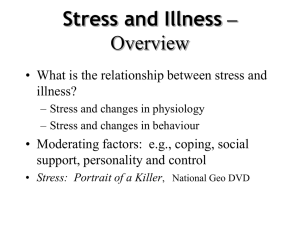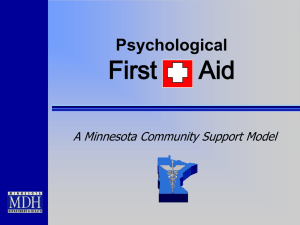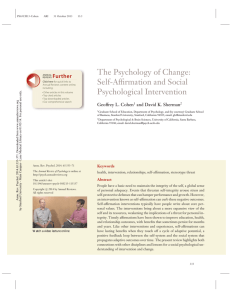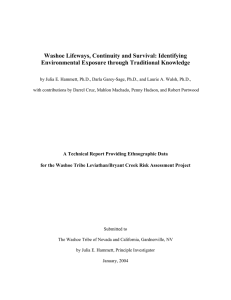PROBLEM-FOCUSED THERAPY
advertisement
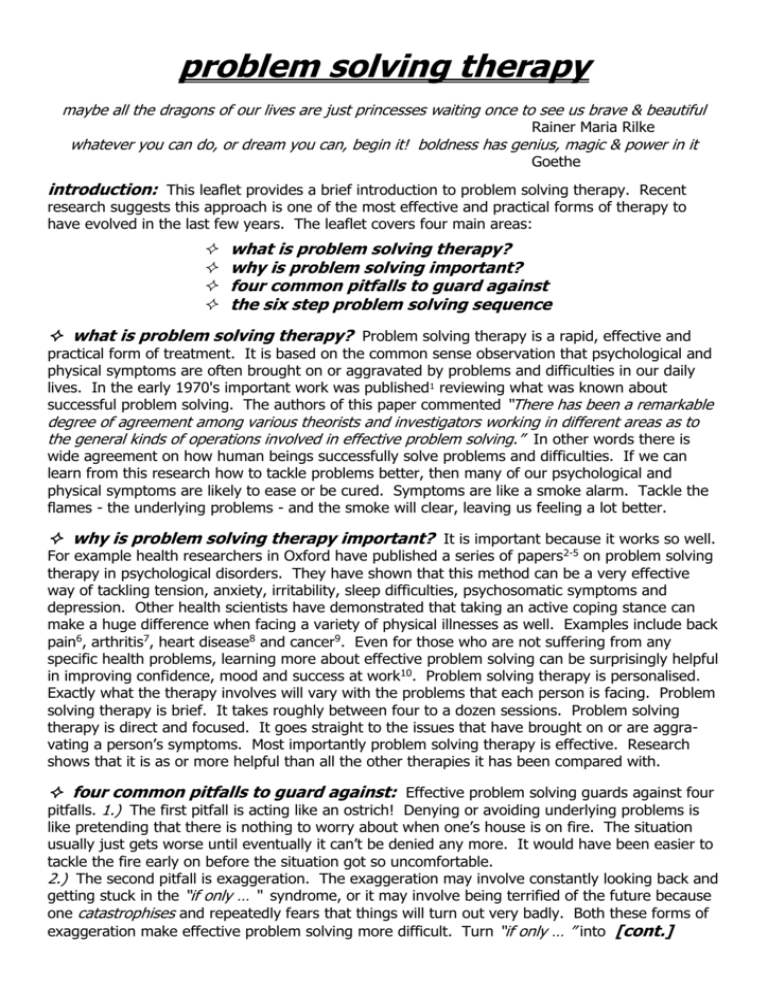
problem solving therapy maybe all the dragons of our lives are just princesses waiting once to see us brave & beautiful Rainer Maria Rilke whatever you can do, or dream you can, begin it! boldness has genius, magic & power in it Goethe introduction: This leaflet provides a brief introduction to problem solving therapy. Recent research suggests this approach is one of the most effective and practical forms of therapy to have evolved in the last few years. The leaflet covers four main areas: what is problem solving therapy? why is problem solving important? four common pitfalls to guard against the six step problem solving sequence what is problem solving therapy? Problem solving therapy is a rapid, effective and practical form of treatment. It is based on the common sense observation that psychological and physical symptoms are often brought on or aggravated by problems and difficulties in our daily lives. In the early 1970's important work was published1 reviewing what was known about successful problem solving. The authors of this paper commented “There has been a remarkable degree of agreement among various theorists and investigators working in different areas as to the general kinds of operations involved in effective problem solving.” In other words there is wide agreement on how human beings successfully solve problems and difficulties. If we can learn from this research how to tackle problems better, then many of our psychological and physical symptoms are likely to ease or be cured. Symptoms are like a smoke alarm. Tackle the flames - the underlying problems - and the smoke will clear, leaving us feeling a lot better. why is problem solving therapy important? It is important because it works so well. For example health researchers in Oxford have published a series of papers2-5 on problem solving therapy in psychological disorders. They have shown that this method can be a very effective way of tackling tension, anxiety, irritability, sleep difficulties, psychosomatic symptoms and depression. Other health scientists have demonstrated that taking an active coping stance can make a huge difference when facing a variety of physical illnesses as well. Examples include back pain6, arthritis7, heart disease8 and cancer9. Even for those who are not suffering from any specific health problems, learning more about effective problem solving can be surprisingly helpful in improving confidence, mood and success at work10. Problem solving therapy is personalised. Exactly what the therapy involves will vary with the problems that each person is facing. Problem solving therapy is brief. It takes roughly between four to a dozen sessions. Problem solving therapy is direct and focused. It goes straight to the issues that have brought on or are aggravating a person’s symptoms. Most importantly problem solving therapy is effective. Research shows that it is as or more helpful than all the other therapies it has been compared with. four common pitfalls to guard against: Effective problem solving guards against four pitfalls. 1.) The first pitfall is acting like an ostrich! Denying or avoiding underlying problems is like pretending that there is nothing to worry about when one’s house is on fire. The situation usually just gets worse until eventually it can’t be denied any more. It would have been easier to tackle the fire early on before the situation got so uncomfortable. 2.) The second pitfall is exaggeration. The exaggeration may involve constantly looking back and getting stuck in the “if only … “ syndrome, or it may involve being terrified of the future because one catastrophises and repeatedly fears that things will turn out very badly. Both these forms of exaggeration make effective problem solving more difficult. Turn “if only … ” into [cont.] “next time … ”, and realise that catastrophising is based on fantasy. We don’t know the future. We do know however that the future is often strongly affected by what we do and how we react in the present. 3.) The third pitfall is destructiveness of ourselves and others. Often when faced with difficult problems we slide into self-damaging behaviours such as excessive drinking, eating or smoking. We may also reduce helpful activities like physical exercise and time spent with people we like. This destructiveness can affect others as well. We may become irritable, impatient, thoughtless and self-involved. None of this really helps much and in the longer term it only aggravates the whole situation. 4.) The fourth pitfall to avoid is knee-jerk responding. Grabbing at the first solution that comes to mind is rarely the most effective way to solve a problem. We usually do considerably better if we have identified various possible solutions, thought them through carefully and then selected what look like the best choices. The sequence given below explains this in more detail. the six step problem solving sequence: The letters ACBCDC stand for the six steps of an effective problem solving sequence. I.) attitude is crucial. William Blake said “The eye altering alters all.” How we see things makes a huge difference to how we feel. Realise three things when facing problems. Firstly having problems is normal, they appear in everyone’s life sooner or later (see “Difficulties are … normal” handout for more details on this). Secondly the symptoms are brought on or aggravated by the problems. Tackle the problems and the symptoms will ease. Thirdly taking an active coping stance is crucial. The eventual outcome is likely to be strongly affected by our actions and thoughts. II.) clarification is helpful. Clarify what the problems and difficulties really are … and also how bad the symptoms are. The symptoms are like a smoke alarm or like a thermometer. The symptoms tell us that all is not well, that there are problems that need to be tackled. It is often helpful to have some kind of estimate of how bad the symptoms are - for example one can use the “Symptom severity scale” or some other measure as a yardstick. Clarifying and tackling the problems helps ease the symptoms. One can monitor this improvement with a symptom scale. If the symptoms are not easing then one knows that some of the important problems have been missed or are not being tackled effectively enough. III.) brainstorm possible solutions. Select the most important problem or one that looks most like it can be tackled. Solutions can be external – doing something to alter the problem or difficulty. Solutions can just as importantly be internal – changing how I think and feel about a situation. Brainstorm possible external and internal solutions to the problem you have selected. Treat the brainstorming as a kind of game. To start with don’t look for good solutions, look for quantity. Research shows that if you come up quickly with a dozen or so largely crazy or poor solutions, you can then sift through them adapting, changing and combining them to produce some really helpful ideas. If you try to come up with a few extremely good solutions straight away, there is a danger that you become over critical and don’t achieve anything particularly useful. Try it. Give yourself three minutes and jot down as many off-the-top-of-your-head solutions as you can. IV.) choose solutions that look as though they could contain something useful. Sift through. Adapt, alter, change, combine. You are likely to find there are some reasonable ideas that you can at least begin with. Remember that both external actions and internal attitude changing are worth considering. You can use changes in the symptoms to monitor if you are going in the right direction or not. The solutions being used can then be changed if progress is not as quick as you would hope. V.) do it. Get started. If appropriate, break the solutions down into smaller tasks. Work out when you can do the initial task. Get going. It is so often a very good feeling to realise that you have started the process of making things better. A tunnel with a light at the end is very different from a tunnel that is completely dark with no sign of possible improvement anywhere in sight. [cont.] VI.) confirm that you are on track. Every now and again recheck your symptom levels. Are they improving? Remember the symptoms are like a smoke alarm or thermometer. They can tell you whether you are being effective in tackling the problems and even whether you have selected the right problems to work on. It is often hard to remember exactly how you were feeling some months ago. This is where a written record of your initial symptom severity and how it has changed can be so helpful. You can chart your progress and see whether you are on course. conclusion: Problem solving therapy is personalised, focused and effective11,12. It is a way of life. If you find that you are bothered by psychological or physical symptoms that won’t clear up reasonably quickly on their own, consider problem solving. Research has shown repeatedly that an active, coping, problem solving approach is extremely useful for helping us become physically healthier, psychologically happier and feel generally more fulfilled. references: 1. D’Zurilla TJ & Goldfried MR Problem solving and behavior modification J Abnorm Psychol 1971;78:107-26 2. Catalan J, Gath DH, Anastasiades P, Bond SAK, Day A & Hall L Evaluation of a brief psychological treatment for emotional disorders in primary care Psychol Med 1991;21:1013-18 3. Mynors-Wallis LM & Gath DH Brief psychological treatments Int Rev Psychiatry 1992;4:301-6 4. Mynors-Wallis LM, Gath DH, Lloyd-Thomas AR & Tomlinson D Randomised controlled trial comparing problem solving treatment with amitriptyline and placebo for major depression in primary care Br Med J 1995;310:441-5 5. Wilkinson P & Mynors-Wallis L Problem-solving therapy in the treatment of unexplained physical symptoms in primary care: a preliminary study J Psychosom Res 1994;38:591-8 6. Keefe FJ, Crisson J, Urban BJ & Williams DA Analyzing chronic low back pain: the relative contribution of pain coping strategies Pain 1990;40:293-301 7. Affleck G, Urrows S, Tennen H & Higgins P Daily coping with pain from rheumatoid arthritis: patterns and correlates Pain 1992;51:221-229 8. Garcia L, Valdes M, Jodar I, Riesco N & de Flores T Psychological factors & vulnerability to psychiatric morbidity after myocardial infarction Psychother Psychosom 1994;61:187-94 9. Fawzy FI, Fawzy NW, Hyun CS et al Malignant melanoma. Effects of an early structured psychiatric intervention, coping, and affective state on recurrence & survival 6 years later Arch Gen Psychiatry 1993;50:681-689 10.Duckworth DH Evaluation of a programme for increasing the effectiveness of personal problem-solving Br J Psychol 1983;74:119-27 11.Hawton K & Kirk J Problem-solving in Hawton K, Salkovskis PM, Kirk J & Clark DM (ed’s) Cognitive behaviour therapy for psychiatric problems Oxford: Oxford Medical Publications, 1989 12.Mynors-Wallis LM & Gath DH Problem-solving treatment manual cost £5 from Oxford University Dept Psychiatry, Warneford Hospital, Oxford OX3 7JX Dr James Hawkins, c/o "Good Medicine", 78 Polwarth Terrace, Edinburgh EH11 1NJ. 0131-337 8474 (weekdays 5.00 to 9.00pm).






